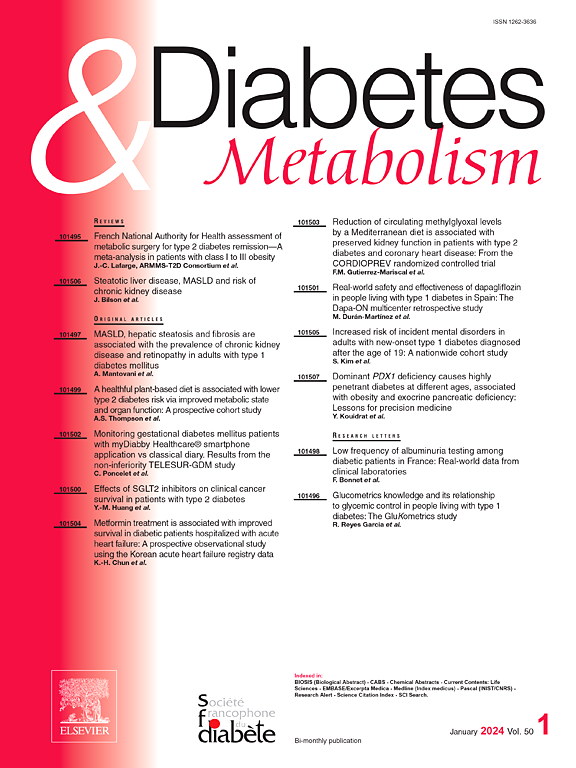SGLT2 inhibitors and the risk of hepatocellular carcinoma in patients with MASLD and Type 2 diabetes
IF 4.7
2区 医学
Q1 ENDOCRINOLOGY & METABOLISM
引用次数: 0
Abstract
Background
- Hepatocellular carcinoma (HCC) is increasingly driven by non-viral causes, especially metabolic dysfunction–associated steatotic liver disease (MASLD), which is common in type 2 diabetes mellitus (T2D). No pharmacologic agent is currently approved for HCC chemoprevention.
Objective
- To evaluate the association between sodium–glucose cotransporter-2 inhibitor (SGLT2i) use and risks of HCC and all-cause mortality in patients with MASLD and T2D.
Design
- Multinational, retrospective cohort study using the TriNetX federated electronic health record network (2005–2025). Adults aged 18–90 years with non-viral MASLD and pre-existing T2D were identified. We applied a 1-year washout, used an active-comparator design, and performed 1:1 propensity score matching. Adjusted hazard ratios (aHRs) were estimated with Cox models.
Results
- After matching, 93,930 SGLT2i users were compared with 93,930 active comparators with excellent covariate balance. Median follow-up was 3.24 years (IQR 1.72–5.09) in the SGLT2i group and 3.25 years (IQR 1.72–5.08) in comparators. HCC occurred in 43 (0.05 %) SGLT2i users vs 74 (0.08 %) comparators (aHR 0.43; 95 % CI 0.29–0.63). All-cause mortality was 5.32 % vs 10.50 % (aHR 0.34; 95 % CI 0.33–0.35). Results were consistent across subgroups and sensitivity analyses, including time-anchored landmark analyses. Risk reductions were also observed for liver fibrosis/cirrhosis and hepatic nodules.
Conclusions
- Among patients with MASLD and T2D, SGLT2 inhibitor use was associated with lower risks of HCC and all-cause mortality compared with active comparators. While residual confounding cannot be excluded, these findings support prospective evaluation of SGLT2 inhibitors for liver-related risk reduction in this population.
SGLT2抑制剂与MASLD和2型糖尿病患者肝细胞癌的风险
背景-肝细胞癌(HCC)越来越多地由非病毒原因引起,特别是代谢功能障碍相关的脂肪变性肝病(MASLD),这在2型糖尿病(T2D)中很常见。目前还没有药物被批准用于肝细胞癌的化学预防。目的:评估钠-葡萄糖共转运蛋白2抑制剂(SGLT2i)的使用与MASLD和T2D患者HCC风险和全因死亡率之间的关系。设计-使用TriNetX联合电子健康记录网络(2005-2025)的多国回顾性队列研究。年龄在18-90岁的非病毒性MASLD和先前存在的T2D的成年人被确定。我们采用了1年的洗脱,采用了主动比较器设计,并进行了1:1的倾向评分匹配。校正风险比(aHRs)采用Cox模型估计。结果-匹配后,93,930名SGLT2i用户与93,930名活跃比较者进行了比较,协变量平衡良好。SGLT2i组中位随访时间为3.24年(IQR为1.72-5.09),对照组中位随访时间为3.25年(IQR为1.72-5.08)。43例(0.05%)SGLT2i使用者发生HCC,而74例(0.08%)对照者(aHR 0.43; 95% CI 0.29-0.63)。全因死亡率为5.32% vs 10.50% (aHR 0.34; 95% CI 0.33-0.35)。结果在亚组和敏感性分析中是一致的,包括时间锚定的里程碑分析。肝纤维化/肝硬化和肝结节的风险也有所降低。结论:在MASLD和T2D患者中,使用SGLT2抑制剂与活性比较物相比,HCC风险和全因死亡率较低相关。虽然不能排除残留的混杂因素,但这些发现支持SGLT2抑制剂在该人群中降低肝脏相关风险的前瞻性评估。
本文章由计算机程序翻译,如有差异,请以英文原文为准。
求助全文
约1分钟内获得全文
求助全文
来源期刊

Diabetes & metabolism
医学-内分泌学与代谢
CiteScore
12.00
自引率
4.20%
发文量
86
审稿时长
13 days
期刊介绍:
A high quality scientific journal with an international readership
Official publication of the SFD, Diabetes & Metabolism, publishes high-quality papers by leading teams, forming a close link between hospital and research units. Diabetes & Metabolism is published in English language and is indexed in all major databases with its impact factor constantly progressing.
Diabetes & Metabolism contains original articles, short reports and comprehensive reviews.
 求助内容:
求助内容: 应助结果提醒方式:
应助结果提醒方式:


